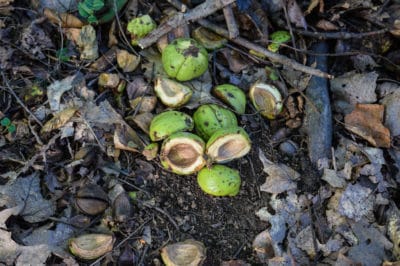The Best Nuts for Harvesting
Finding the best-tasting hickory nuts is the easy part, because they come from the most easily recognizable hickory (Carya spp.) tree. Shagbark hickories (Carya ovata) stand out for their long, narrow plates of bark that pull away from their trunks at both ends. They’re the straight, lance-leaved trees that appear covered in shaggy, dark-gray fur.
When to Harvest
Depending on where they grow in USDA plant hardiness zones 4 through 9, shagbark hickories begin dropping their nuts between late summer and early fall. The nuts’ green husks will become brown and split into four equal quarters, revealing the creamy-white shells beneath. Be ready to harvest as soon as you spot fallen nuts, or the local squirrels will almost certainly beat you to them.
How to Harvest
Things you’ll need:
- Collection bags
- Long pole
- Tarps
- Buckets for rinsing the nuts
- Power hose
- Flat surface for drying the nuts
Collect the nuts that have already fallen and then spread your tarps underneath a hickory tree. Shake its branches with a long pole to release more nuts. Empty the tarps into your collection bags, discarding the nuts with holes, wrinkled husks or discolored shells.
Peel the husks, fill each bucket halfway with nuts and blast them clean with a power hose. Discard the floaters, drain the buckets and spread the nuts on a flat surface in the sun for four or five days to dry. Stir them occasionally for even air flow.
Shelling
Place a nut on its side on a hard, flat surface and strike it with a hammer just above the stem end. This sends a shock wave through the inner membrane dividing the nutmeats and into the shell, which will break into six pieces when hit correctly. Remove the nutmeats from the shell pieces by hand to avoid fragmenting them.
Storing Your Hickory Nuts
Unless your hickory nuts are properly stored, the oils responsible for their rich, smoky taste will quickly turn rancid. Stored in the freezer in sealable plastic bags with all the air removed, or in airtight plastic containers, they’ll stay fresh for up to one year.
